The following article is translated from the Japaneses version of Spotlight Research No. 137.

This Spotlight Research is presented by Dr. Noriaki Ozaki from Itami group ( JST-ERATO Itami Molecular Nanobarbon Project ), Nagoya University.
The JST-ERATO Itami Molecular Nanobarbon Project investigates novel functionality and application of nanocarbon materials founded on the synthesis of molecular nanocarbon materials.als for his work which is published in Angew. Chem.
Noriaki Ozaki, Hirotoshi Sakamoto, Taishi Nishihara, Toshihiko Fujimori, Yuh Hijikata, Ryuto Kimura, Stephan Irle, and Kenichiro Itami
“Electro-Activated Conductivity and White Light Emission of a Hydrocarbon Nanoring-Iodine Assembly”
Angew. Chem., Int. Ed. 2017, 56, 11196.doi:10.1002/anie.201703648
Prof. Hirotoshi Sakamoto, the group leader of the molecular assembly group and Prof. Kenichiro Itami, the principal investigator have commented on Dr. Ozaki.
The purpose of our lab is to explore the functionality of molecular nanocarbons, and Dr. Ozaki is a very capable member equipped with the essential skills. We had encountered several obstacles in our research, and Dr. Ozaki struggled to overcome the difficulties by developing new methods. His determined attitude has inspired me. You can see his courage from his joining this organic chemistry project while he had a background in physical chemistry. Moreover, he has perfectly fused knowledge of these two fields and designed the research in the way only he is able to. “Turn and face the strange (from David Bowie’s song Changes)” is one of the most important virtues as a researcher. I expect that Dr. Ozaki will make great accomplishments in whichever field he chooses in the future.
—-Hirotoshi Sakamoto
My favorite quote is “Creativity is just connecting things” by Steve Jobs, which have inspired me to commence the ERATO project. Dr. Ozaki, with the great courage and knowledge he possesses, has demonstrated such creativity. In this research, we have seen the amazing functionalities of the new composite material of iodine and hydrocarbon nanoring. However, it is not just mixing of chemicals, it is the combination of active research fields including solid-state physics, mesoporous materials and organic chemistry. I can foresee that Dr. Ozaki will become a star researcher in the future.
—- Kenichiro Itami
Q1. What is your research about? Can you briefly walk us through your work?
We have synthesized a hydrocarbon nanoring-iodine assembly ([n]CPP-I, Figure a) by confining iodine inside [n]cycloparaphenylene (where n is 9,10 or 12 in this research). We then investigated the electrical conductivity and the photoluminescence properties of this material. While neither of the two components alone shows electrical conductivity, upon electric stimulus, the composite material shows decreased electric resistivity. The resistivity drop is the largest for [10]CPP-I. Upon stimulus, the resistivity drop was around 1000 times and the sample became electrically conductive. Moreover, the color of light emission also changed from greenish-blue to white. The stimuli-responsivity of [10]CPP-I is accounted by the structural change of solid CPP triggered upon electric stimulus. It demonstrates the feasibility of the general strategy that “By combining a stimulus-responsive porous host and a functional molecule, one can obtain stimuli-responsive multi-functional material.”

(a) Representative synthesized material [10]CPP-I (b) Resistivity plotted against time (c) Fluorescence color change before and after electric stimuli (d) Color change of fluorescence in the standard chromaticity diagram
Q2. What is creative about this research? How effort did you make to realize your ideas?
It was not easy to measure the in situ electric stimulus accurately, and we made effort on designing and setting up the measuring apparatus. Similar to my answer to Q3, it is crucial to reduce the error as much as possible in order to get the right conclusion. In the end, we managed to observe the in situ stimuli-response by employing multiple spectroscopic techniques including X-ray diffraction and XAFS. Hopefully, this method will be useful for our future research too.
Q3. What do you think is the major challenge of this research? How did you overcome it?
In the beginning, we had no idea of what was happening and the hardest part was to understand the cause of electrical conductivity. The phenomenon that “the resistivity decreases upon electric stimulus” was observed for several weeks at the beginning of this project, and we wondered what the major cause was. Aside from the mechanism mentioned in our paper, other possibilities also exist, including inadequacy in sample preparation and external temperature change. We had to exclude every other possibility, and it was a tremendous task. We did a lot of literature reviewing and refining of the experimental procedures. Through this process, we eventually proved our hypothesis.
Q4. What kind of chemistry do you want to engage in?
I was fortunate to join the Itami group as a postdoctoral researcher. Here, I get to work with many organic molecules I’ve never known before. For me, organic molecules themselves are already intriguing, yet they become more charming if they possess good properties, as we have demonstrated in this research. From now on, I want to dedicatedly investigate and reveal the potential of these “potentially fantastic molecules”.
Q5. As a final remark, can you give the readers some advice or message?
When I was a student, I studied researched on metal complexes and the properties of inorganic materials guided by Prof. Shin-ichi Ohkoshi. After that, I started my postdoctoral study at the Itami group, which is thought to be a holy land for organic synthesis. It was a big transition in research disciplines. However, I think it is the discovery of the connection between the two disciplines that has led to the publication of this award-winning research. In this process, I have realized that although chemistry is a very broad subject containing various research fields, any field is not isolated and there must be connection and intersection. The readers of this article must be interested in chemistry or science in general. At the intersection of your and my research field, there must be novel studies lying undiscovered. If we have the opportunity, let’s enjoy research together. Thanks for your interest.
